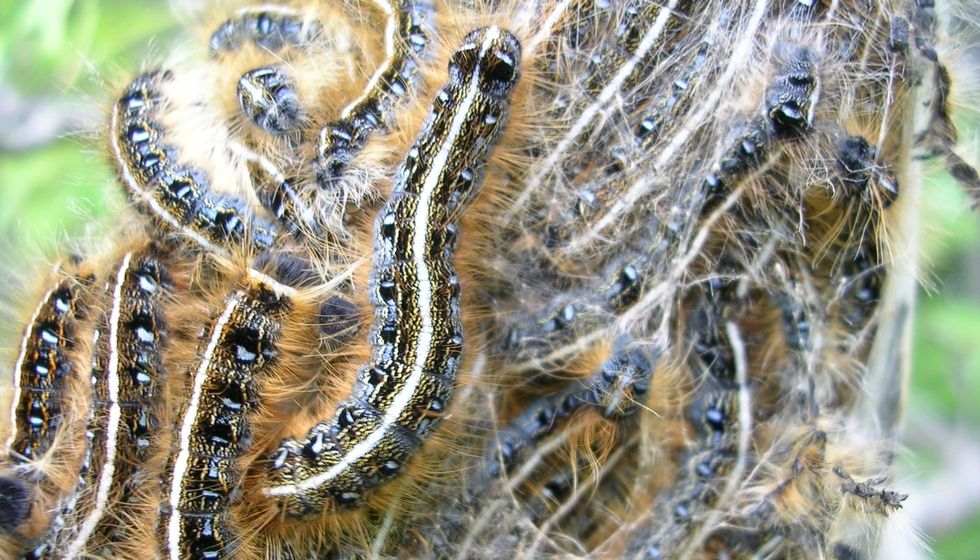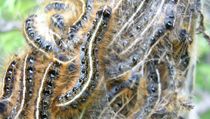The biological genus Malacosoma, categorized under the family Lasiocampidae, is known to encompass about 26 different species of moderately sized moth larvae or caterpillars known as tent caterpillars. These tent caterpillars are particularly known for their large silk tents.
Faithful to their infamous social behavior, the members of Malacosoma americanum work in cooperation with the other members of their species immediately after emerging from their eggs, in order to build their tents.
The tents of these moths on the host plant serve as shelter, in protection from predators and dwelling for their sleep cycles during the night.
The eastern tent caterpillar (Malacosoma americanum) is known to show parasitic behavior during the late spring days by foraging on leaves of different hosts. However, these pests do not cause any long-lasting damages, as long as the infestation of this pest fall webworm is not on a large scale.
The favored host trees for these caterpillars are apple trees and cherry trees. Here are some of the most important facts about the eastern tent caterpillar. For more relatable content, check out these eastern Hercules beetle facts and stink bug facts for kids.
Eastern Tent Caterpillar Interesting Facts
What type of animal is an eastern tent caterpillar?
The eastern tent caterpillar (Malacosoma americanum) is a type of caterpillar or moth larvae classified under the biological family of tent caterpillars. Malacosoma americanum is widely recognized for its silk tents and social behavior, which in comparison to other larvae is prominently observed in eastern tent caterpillars and fall webworms.
What class of animal does an eastern tent caterpillar belong to?
The eastern tent caterpillar belongs to class Arthropoda. Though these moderately sized caterpillars are known to pose no threat to humankind the adult moth exhibits some fatal impacts on horses when ingested by them during grazing.
How many eastern tent caterpillars are there in the world?
There are no exact details about the total populations of eastern tent caterpillars, however, no immediate threats are reported to their populations. Therefore it can be safely pointed and assumed that the present population of Malacosoma americanum is quite stable.
Where does an eastern tent caterpillar live?
The tent caterpillar (Malacosoma americanum (Fabricius)) can be located along the eastern and central stretch of the United States like the fall webworm. Additionally, these pests can also be traced along the western Rocky Mountains. Their host plants include apple trees and cherry trees.
What is an eastern tent caterpillar's habitat?
The prime habitation of eastern tent caterpillars includes forests with fruit trees where these pests build tents (largest among the tent caterpillar species). The eastern tent caterpillar is also found near human habitations particularly during the late spring or early summer days, much like the fall webworm.
The common plant species used by these caterpillars for nesting include forest trees and deciduous shade trees like maple, peach, cherry, and willow.
Who do eastern tent caterpillars live with?
Eastern tent caterpillars are found in groups known as cohorts which include as many as 50-200 individuals. These pests lay their eggs on the thin branches of cherry trees or on the branches of apple trees and the eggs will hatch in the early weeks of April.
How long does an eastern tent caterpillar live?
The total life cycle of Malacosoma americanum is about 10 months. Wherein the adult males are known to survive for a week or more, however, in contrast to this the females Malacosoma americanum breathe their last soon after laying eggs, much like the fall webworm insect.
How do they reproduce?
During the breeding season, the male eastern tent caterpillar intently seeks out females for copulation. In fact, the competition for breeding is quite high amongst the male members, which in general are in higher ratios in comparison to the female counterparts (in most tent caterpillar populations).
After selecting potential partners short copulation is followed resulting in the fertilization of gametes. Following fertilization, females lay about 150-400 eggs in protected areas in the form of tent caterpillar egg masses in loosely woven webs.
Eastern tent caterpillar egg masses do not encompass foliage. The female eastern tent caterpillars die soon after laying the eggs.
What is their conservation status?
The conservation status of the eastern tent caterpillar as of now is Not Evaluated by IUCN. These insects are present in abundance on a malus tree and a prunus tree in their natural habitat.
Eastern Tent Caterpillar Fun Facts
What do eastern tent caterpillars look like?
Generally, the body of these Malacosoma is black-toned, with patterned white stripes running down their dorsal body parts and brown as well as yellow lines along the lateral regions of the body. Blue strips in combination with white spots can also be observed on the body of eastern tent caterpillars.
When these tent caterpillars undergo metamorphosis to reach their adult moth forms, their body takes on a reddish-brown shading with white strips on their wings.
How cute are they?
Eastern tent caterpillars are not particularly cute, in fact, the hairy look and dark shading of these moderately sized tent caterpillars give them a coarse look that is far from cute.
How do they communicate?
The communication in eastern tent caterpillars includes chemical channels along with visual perception. Malacosoma americanum release pheromones along their foraging trails which are perceived by the other members of their species. These tent caterpillars are also known to exhibit a sense of light to perceive their surroundings.
How big is an eastern tent caterpillar?
Eastern tent caterpillars, in general, are not very large. These pests are moderately sized with an average length between 1.6-2 in (4-5 cm).
How fast can eastern tent caterpillars move?
Eastern tent caterpillars are extremely slow-moving creatures who generally prefer to remain on their preferred trees looking for their food source.
How much does an eastern tent caterpillar weigh?
There are no exact details about the weight of eastern tent caterpillars, however, these members of the Lasiocampidae family are known to be extremely light in terms of weight.
What are the male and female names of the species?
Generally, the males are referred to as male eastern tent moths or caterpillars, while the females are known as female eastern tent caterpillars. The caterpillars are not known to feed within their webs but do gather there at night. The only way to identify them is the size, as the females are larger in size than males.
What would you call a baby eastern tent caterpillar?
The offspring of eastern tent caterpillars are known as baby caterpillars or young eastern tent moths. The larvae feed on leaves, sometimes defoliating trees but will never feed within the webs.
What do they eat?
Eastern tent caterpillars feed on the leaves or branches of apple, peach, chokecherry, maple, and oak. During the initial days of their life, these tent caterpillars also feed on the coating surrounding their egg mass.
The known predators for these insects include tiny braconid, ichneumonid, and chalcid wasps.
Are they poisonous?
The species of eastern tent caterpillar is known to exhibit certain toxicity levels, which is particularly fatal to the reproductive process in horses. Besides this, eastern tent caterpillars are not known to pose any threats to the human population.
Would they make a good pet?
Keeping an eastern tent moth as a pet is not suitable as they are a wild animal.
Did you know...
The cohorts of Malacosoma americanum are known to weave large silk tents which are utilized by these tent caterpillars for protection from predators, for food storage, and as sleeping tents during the night.
In order to mark off or reinforce their trails on the host tree, these moderately sized, hairy members of Malacosoma americanum species emit pheromones.
The members of the eastern tent caterpillar are gregarious in nature, that is this pest is found in close proximity forming groups with their siblings which may include as many as 200 individuals.
The toxins released by eastern tent caterpillars are known to induce abortion in horses when this insect is ingested by the grazing mare.
The eastern tent caterpillar stays in its cocoon on the tree for a period of three weeks, after which the adult moth emerges.
Do eastern tent caterpillars turn into butterflies or moths?
Yes, just like other moths, the members belonging to the eastern tent caterpillar pest species undergo metamorphosis, that is, the transformation process including four stages from egg to adult. Malacosoma americanum transit from egg, larva, and pupa phase to develop into adult tent moth.
How did the eastern tent caterpillar get its name?
This pest builds tents, in fact, the largest among the tent caterpillar species and hence draw their name eastern tent caterpillar. You can safely touch these caterpillars as they pose no risk to humans on touching as there is no risk of any venom being transferred to humans by these pests.
Here at Kidadl, we have carefully created lots of interesting family-friendly animal facts for everyone to discover! Learn more about some other arthropods from our saddleback caterpillar facts and monarch butterfly facts pages.
You can even occupy yourself at home by coloring in one of our free printable eastern tent caterpillars coloring pages.









